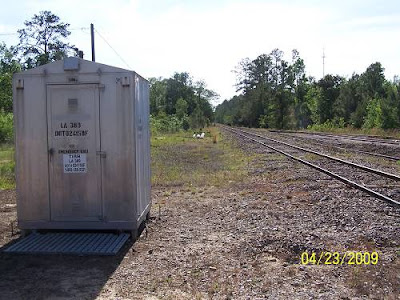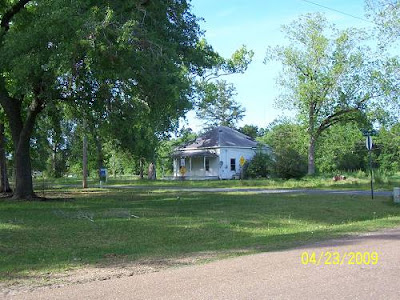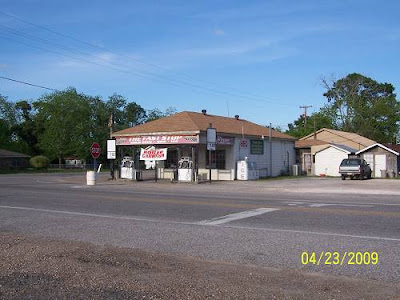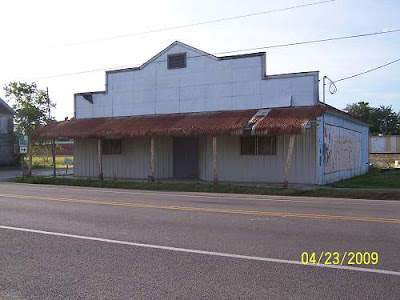Here's the last page. It's a collection of stuff I should have included on the appropriate pages but was too lazy to do it. First, some added maps.
The J&E continues to Kirbyville. Now you know the source of the town's name. I will probably not trace the Texas portion to J&E Junction from Bon Weir. It's just too far out there. Or, maybe I will because it is too far out there. I need goals or nothing happens. Here's the added stuff.
Merryville is an interesting place. With a little research and time, there's no telling what could be discovered. I believe its history is linked to the disputed area between lands owned by France/USA and Spain.

DeQuincy is an interesting place. It has a grand old depot and the town has a yearly Railroad Festival, I think. Anyway It was a railroad center and one of the anchors of the grand design as I see it. My software shows past and present rails going into that town so I'll share what I see.

Down at Lake Charles it looks/looked like this. Everything tied together.

DeRidder was a crossroads, also. Read Block's write on Calcasieu Parish back on page 3.

Now here's the mill engine I found at Oakdale. Of course it was no secret, sitting 50 feet from US 165 in south Oakdale. E lusted after it, but being denied gave me reasons he didn't want it. I've used that rationalization with other lust. I was thinking of fast motorcycles, Gilbert.
.jpg)
.jpg)
.jpg)
.jpg)
Here's looking at the old yard. The pictures were taken from the RROAK weigh point.

And what about that "Do Not Hump" graffiti?
Several "friends of History Hunts" chimed in.
"Just in case E. hasn't gotten back to you, humping refers to a method of shunting freight cars around in a railroad yard. Many yards were built with a slight hill or hump, and the crew would run the train until the cars were on top of the hump, and uncouple them, one by one. As they were released, gravity would roll the cars through the yard, while in the tower, someone would work the levers to throw the switches so the car would roll to the correct place in the yard (this is how they would make up new trains that would later leave the yard). You might wonder why they didn't just shunt them around with an engine - too time consuming.
Obviously this is hard on cars and contents, especially if the car picks up a bit of speed rolling down the incline. The railroads had methods of slowing the cars down, but still there would be some crashing and banging, plus the risk of derailment.
Cars with delicate contents, and especially tank cars with hazardous chemicals, would be labeled "Do Not Hump" for such reasons.
I can't imagine why the railroad would have a locomotive labeled "Do Not Hump". I wondered if the phrase was spray painted on it as a joke".
That was a wonderful explanation, thanks V.
E. did get back and offered this. It has been considerably shortened due to a lack of bandwidth in the northern hemisphere.
"....now for the engine in Oakdale. It is a 4 wheel GE diesel of the type used to switch a steel mill.... but no one seems to know anything about it. [it might belong to the parish?] No one seems to know how it got there, what it is doing there, or who it belongs to. ....it could belong to International Paper because they are the people who own Arizona Chemical....."
"The Do Not Hump refers to sending the locomotive over the hump in a hump yard, where they push the cars up on an artificial hill, and when they roll down, they are navigated to the proper departure track to get to the train that they need."
He added some tick knowledge. Now there is some useful info, especially for the likes of me. Here it is: "The Louisiana Wood Tick does not carry anything bad like Rocky Mtn. Spotted Fever or Lyme disease. Get it out clean, put lots of antibiotic ointment on it and eventually all you have left is a red spot".
Of course E was the one interested in the railroad ties seen on page 2. He asked, "Do you have any idea who owns all of the ties in DeRidder?...... I think that the railroad still belongs physically to the Burlington Northern Santa Fe, but the company that operates the line is called the Timber Rock Railroad. I wonder which entity actually owns the ties, or if they are selling them somewhere? I could still use several hundred ......"
I offered a solution but he has not responded.
That's it. I hope this article has found a place on your library shelf. If not, give it to someone, sell it at a garage sale. There's bound to be someone out there that will buy it. Oh. I want to show you what Al just found at one of those garage sales for 3 bucks.
.jpg)
.jpg)
He goes to those things at 6 AM. Now I know why. Bye.

.jpg)
.jpg)
.jpg)
.jpg)
.jpg)

.jpg)
.jpg)
.jpg)

.jpg)
.jpg)
.jpg)
.jpg)
.jpg)
.jpg)
.jpg)
.jpg)
.jpg)
.jpg)
.jpg)
.jpg)
.jpg)
.jpg)
.jpg)
.jpg)
.jpg)
.jpg)
.jpg)
.jpg)
.jpg)
.jpg)
.jpg)
.jpg)
.jpg)
.jpg)
.jpg)
.jpg)
.jpg)
.jpg)
.jpg)

.jpg)
.jpg)
.jpg)
.jpg)
.jpg)
.jpg)
.jpg)
.jpg)
.jpg)
.jpg)
.jpg)